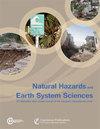高寒地区雪崩灾害的大尺度风险评价
IF 4.7
2区 地球科学
Q1 GEOSCIENCES, MULTIDISCIPLINARY
引用次数: 2
摘要
摘要雪崩是影响山区人口和基础设施的反复发生的自然灾害,例如最近的2018年和2019年冬季雪崩,当时整个阿尔卑斯山的雪崩造成了相当大的破坏。灾害决策者需要关于雪崩灾害和风险的空间分布的详细信息,以优先考虑并应用适当的适应战略和缓解措施,从而将影响降至最低。在这里,我们提出了一种新的风险评估方法,通过将大规模危险地图与最先进的风险评估工具相结合来评估雪崩风险的空间分布,其中风险被理解为危险、暴露和脆弱性的产物。使用大规模危险指示映射方法RAMMS::LSHIM(快速大规模运动模拟::大规模危险指示图)对危险处置进行建模,并使用ETH Zürich开发的基于Python的概率风险评估平台CLIMADA对风险进行评估。具有30年、100年和300年重现期的情况下的雪崩危险地图基于高分辨率地形模型,3 d雪深增加,自动确定潜在释放区域和防护林数据。雪崩危险40 000个单独的雪崩表示为雪崩强度、测量为压力。风险敞口由表示货币资产空间分布的详细建筑层表示。建筑物的脆弱性由基于EconoMe软件的损坏函数定义,该软件在瑞士投入使用。将危害、暴露和脆弱性分析的结果结合起来,在空间明确的风险图中量化风险。该风险考虑了雪崩发生的概率和强度,以及脆弱、暴露的建筑物的集中度。进行了不确定性和敏感性分析,以捕捉输入参数的固有可变性。这种新的风险评估方法使我们能够量化大面积的雪崩风险,并生成显示特定地点风险空间分布的地图。大规模风险地图可以帮助决策者确定需要缓解和/或适应雪崩危险的区域。本文章由计算机程序翻译,如有差异,请以英文原文为准。
Large-scale risk assessment on snow avalanche hazard in alpine regions
Abstract. Snow avalanches are recurring natural hazards that affect the population and infrastructure in mountainous regions, such as in the recent avalanche winters of 2018 and 2019, when considerable damage was caused by avalanches throughout the Alps. Hazard decision makers need detailed information on the spatial distribution of avalanche hazards and risks to prioritize and apply appropriate adaptation strategies and mitigation measures and thus minimize impacts. Here, we present a novel risk assessment approach for assessing the spatial distribution of avalanche risk by combining large-scale hazard mapping with a state-of-the-art risk assessment tool, where risk is understood as the product of hazard, exposure and vulnerability. Hazard disposition is modeled using the large-scale hazard indication mapping method RAMMS::LSHIM (Rapid Mass Movement Simulation::Large-Scale Hazard Indication Mapping), and risks are assessed using the probabilistic Python-based risk assessment platform CLIMADA, developed at ETH Zürich. Avalanche hazard mapping for scenarios with a 30-, 100- and 300-year return period is based on a high-resolution terrain model, 3 d snow depth increase, automatically determined potential release areas and protection forest data. Avalanche hazard for 40 000 individual snow avalanches is expressed as avalanche intensity, measured as pressure. Exposure is represented by a detailed building layer indicating the spatial distribution of monetary assets. The vulnerability of buildings is defined by damage functions based on the software EconoMe, which is in operational use in Switzerland. The outputs of the hazard, exposure and vulnerability analyses are combined to quantify the risk in spatially explicit risk maps. The risk considers the probability and intensity of snow avalanche occurrence, as well as the concentration of vulnerable, exposed buildings. Uncertainty and sensitivity analyses were performed to capture inherent variability in the input parameters. This new risk assessment approach allows us to quantify avalanche risk over large areas and results in maps displaying the spatial distribution of risk at specific locations. Large-scale risk maps can assist decision makers in identifying areas where avalanche hazard mitigation and/or adaption is needed.
求助全文
通过发布文献求助,成功后即可免费获取论文全文。
去求助
来源期刊
CiteScore
7.60
自引率
6.50%
发文量
192
审稿时长
3.8 months
期刊介绍:
Natural Hazards and Earth System Sciences (NHESS) is an interdisciplinary and international journal dedicated to the public discussion and open-access publication of high-quality studies and original research on natural hazards and their consequences. Embracing a holistic Earth system science approach, NHESS serves a wide and diverse community of research scientists, practitioners, and decision makers concerned with detection of natural hazards, monitoring and modelling, vulnerability and risk assessment, and the design and implementation of mitigation and adaptation strategies, including economical, societal, and educational aspects.

 求助内容:
求助内容: 应助结果提醒方式:
应助结果提醒方式:


